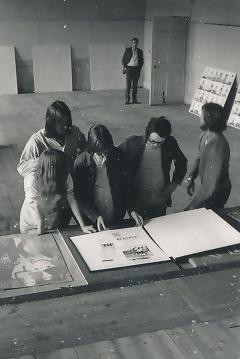21. Student helpers and Düsseldorf SGA curator Jürgen Harten in front of Sigmar Polke’s paintings Solutions I-IV (1969)
Sigmar Polke is considered to be one of the most significant German artists of the post-1945 period. He was included in SGA, but his paintings were damaged in transit.

Sigmar Polke (1941-2010) was a close friend and colleague of Gerhard Richter and Blinky Palermo, Like them, Polke and other artists at Strategy: Get Arts, were Grenzgänger (border-crosser), who left the GDR for West Germany.
From 1961 to 1967, he studied at the Kunstakademie Düsseldorf and was taught by Joseph Beuys, among others.
Along with Richter, Manfred Kuttner, and Konrad Lueg, Polke founded a ‘movement’ ironically called ‘Capitalist Realism’ in 1963.
Polke’s reputation was in the ascendency in the late 1960s. Between 1966 and 1970 he had a number of solo exhibitions in Germany and Holland.
In the 1980s, Polke was at the height of his fame and he featured in several high-profile international exhibitions.
The first comprehensive Polke retrospective was staged at MoMA, New York and Tate Modern in 2014.
Solutions... with a mystery

In examining the entry on Polke on the website of the Demarco Digital Archive (DDA), there is no clear photographic documentation by George Oliver or Demarco of Polke’s contribution to Strategy: Get Arts. The only evidence of his participation is the artist profile page from the 1970 SGA catalogue.
In checking the Hasenkamp transport list for artworks arriving from Düsseldorf in the Richard Demarco Archive at Modern Two (SNGMA), four paintings (Lösungen I-IV) and one film are listed.
Further research on this grouping of four reveals that they were lacquer on canvas paintings comprising one artwork from 1969. They were sold at Sotheby’s New York in May 2013 for 3,525,000 USD. Strategy: Get Arts (1970) is not listed in the exhibition history given by Sotheby’s, which leaps from the Galerie Rudolf Zwirner, Cologne, 1969 to the Städtische Galerie im Lenbachhaus, Munich, 1973.
This absence from the Demarco Digital Archive and the auction house exhibition history seems mysterious, but a closer inspection of all Oliver’s SGA photographs is revealing. In one photograph, Polke canvases can be seen resting against the back wall of an ECA studio, just behind SGA curator, Jürgen Harten. In the Demarco archive at SNGMA, the paintings by Polke are simply listed as ‘Works which arrived in Edinburgh damaged’.
It is possible that they remained in storage for the duration of the exhibition, and at some point after SGA and before the 1973 Lenbachhaus exhibition, the paintings would have been restored.
The location of the photo-panel in ECA building today shows where the work was intended to be sited in the absence of any in situ photographs. It is effectively a ‘ghost’ panel.
Lösungen I-IV (Solutions I-IV) is an important artwork from Polke’s early career: it seems to be a witty response to the rise of Conceptual Art and the importance of seriality and repetition in Minimalist art, as exemplified by the practice of artists such as Sol LeWitt and Joseph Kosuth.
In these four canvases, Polke subverts the ‘beauty’ of mathematical formula which attracted LeWitt and his peers by giving the wrong answers to simple arithmetic, for example, 1 + 1 = 3, 2 + 3 = 6 etc., thereby frustrating the expectation of the viewer for an elegant ‘solution’ as suggested by the title.
It is known that Polke also contributed a film to SGA. This was most likely his first film, a collaboration with Christof Kohlhöfer entitled Der ganze Körper fühlt sich leicht und möchte fleigen… (The Whole Body Feels Light and Wants to Fly…) from 1969, but simply listed as Polke-Film at SGA.
C.W.


